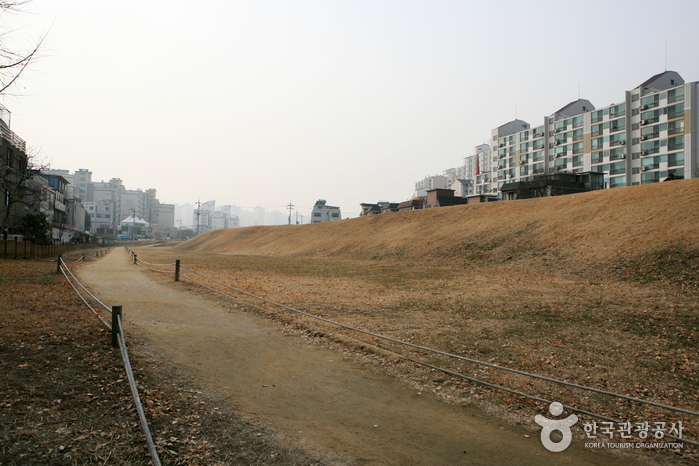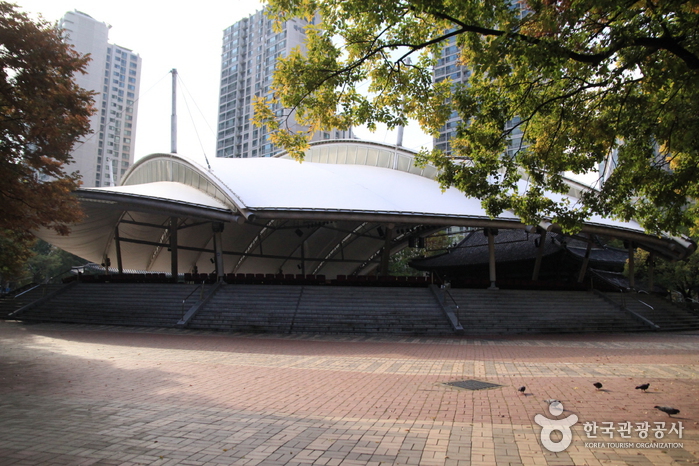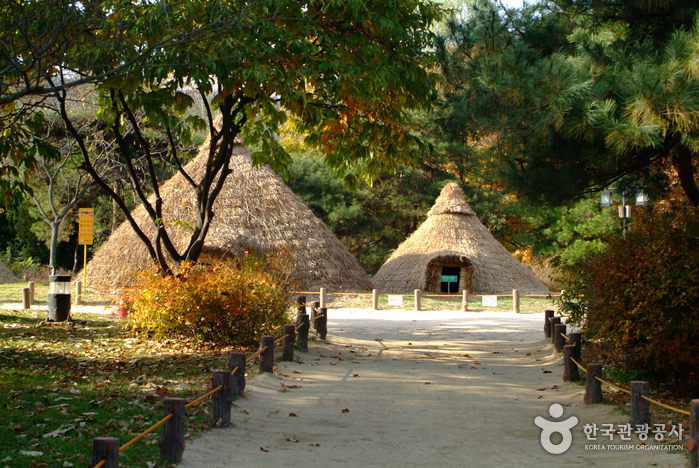Holika Holika - Jamsil Underground Branch [Tax Refund Shop] (홀리카홀리카 잠실지하점)
11.4Km 2024-06-27
Store #F-41 and 42, Jamsil Underground Shopping Center, B265 Olympic-ro, Songpa-gu, Seoul
-
Pungnap-dong Toseong Fortress (서울 풍납동 토성)
11.4Km 2025-01-10
Pungnap-dong, Songpa-gu, Seoul
+82-2-2147-2800
Onjo, the progenitor of Kingdom Baekje, first settled in Wiryeseong Hanam. But exact location is still unknown. One thing for sure, however, is that Pungnaptoseong Fortress, Mongchontoseong Fortress, Bangidong Ancient Tombs of Baekje, Seokchondong Stone Mound Tomb of Early Baekje are the remains of Baekje. Pungnaptoseong Fortress faces Hangang River to its west and connects to Mongchontoseong Fortress to the south. To the northwest faces Achasanseong Fortress over Hangang River and far to the southeast is Namhansanseong Fortress.
Pungnaptoseong Fortress, located at the south end of Cheonhodaegyo Bridge over Hangang River, is one of the remains of Early Baekje. Originally, the fortress was 4km in circumference, but due to massive overflowing of Hangang River during flood season in 1925, most of the fortress was lost and only 2.7km of it remains. To the east of the fortress are 4 vestiges of the fortress gates. The remains from the prehistoric era through the Samguk (Three States) era have been unearthed, indicating that this place was a residential area well before the Baekje Era. Through vigorous excavation, some people suggest that there used to be a palace located here during the Baekje Era.
Amsa-dong Prehistoric Site Museum (암사동선사유적박물관)
11.4Km 2023-12-22
875 Olympic-ro, Gangdong-gu, Seoul
The archaeological sites in Amsa-dong, Seoul, were a collective settlement where people lived during the Neolithic Age about 6,000 years ago and became known to the world after the sand dunes along the Hangang River caved in during the great flood of 1925, exposing numerous pieces of comb-patterned pottery. The area designated as a historic site in 1979, and excavation of the site took place from 1981 to 1988. The cultural heritage protection area was expanded to a total area of 78,133㎡. Currently, nine Neolithic dugout huts and one experiential dugout hut have been restored. The exhibitions currently open to the public are Exhibition Hall 1, which displays a restoration of a Neolithic Age dugout, and Exhibition Hall 2, which displays various panels and models to help understand the prehistoric era as a whole.
Himart - Sanggye Branch [Tax Refund Shop] (하이마트 상계점)
11.4Km 2024-04-19
1641, Dongil-ro, Nowon-gu, Seoul
-
Songpa Naru Park (Seokchonhosu Lake) (송파나루공원 (석촌호수))
11.4Km 2024-10-10
136 Samhaksa-ro, Songpa-gu, Seoul
Songpa Naru Park, also commonly referred to as Seokchonhosu Lake, is a citizen park in Seoul with a jogging course and walking trails. It has two lakes with Songpa-daero Boulevard running in between. Originally, a branch of the Hangang River ran through the site, forming one large lake, but the lake was divided into two with the construction of Songpa-daero Boulevard. The total size of the two lakes is 217,850 ㎡, and they hold about 737 tons of water. The depth of the lakes is 4-5 meters.
Seoul Nori Madang (서울놀이마당)
11.4Km 2021-02-10
136, Samhaksa-ro, Songpa-gu, Seoul
+82-2-2147-2800
Established on December 25, 1984, Seoul Nori Madang offers diverse traditional performances on an outdoor stage to promote Korean folk plays and culture. Performances are regularly held every weekend; it hosts over 120 performances every year and each performance attracts over 1,300 visitors. Within Seoul Nori Madang is Songpa Folk Preservation Association, which offers seminars on folk plays such as Songpa Sandae Nori and Songpa Baekjung Nori for students, free of charge.
Archaeological Site in Amsa-dong, Seoul (서울 암사동 유적)
11.5Km 2021-07-27
875, Olympic-ro, Gangdong-gu, Seoul
+82-2-3425-6520
The Archaeological Site in Amsa-dong reproduces the lifestyle of the Neolithic Era. Even the entrance gate is shaped like a huge dolmen and the trash cans are ancient diagonal-line patterned earthenware. Archaeological Site in Amsa-dong was excavated in 1925 when a flood washed away the soil on the banks of the Hangang River and exposed a large number of diagonal-line patterned earthenware. After several excavations, the Archaeological Site in Amsa-dong was established.
The site was a location for a massive colony, thus many ancient buildings, stone axes and stone arrows have been uncovered as well as countless diagonal-line patterned earthenware. The housing site is round with a spot in the center for fire. The site is colossal and possesses nine mud huts, two exhibition halls displaying ancient artifacts and an open mud hut where visitors can experience life in the Neolithic Era. The site offers many attractions such as mud huts and promenades. Archaeological Site in Amsa-dong is also very educational for children and families who want to learn and experience the Neolithic Age.
Olive Young - Guri Galmae Branch [Tax Refund Shop] (올리브영 구리갈매점)
11.5Km 2024-06-27
24, Sanmaru-ro, Guri-si, Gyeonggi-do
-
Givenchy - Lotte Jamsil Branch [Tax Refund Shop] (지방시 롯데잠실)
11.5Km 2024-04-23
1F, 521, Songpa-daero, Songpa-gu, Seoul
-




![Givenchy - Lotte Jamsil Branch [Tax Refund Shop] (지방시 롯데잠실)](http://tong.visitkorea.or.kr/cms/resource/56/2879256_image2_1.jpg)
 English
English
 한국어
한국어 日本語
日本語 中文(简体)
中文(简体) Deutsch
Deutsch Français
Français Español
Español Русский
Русский